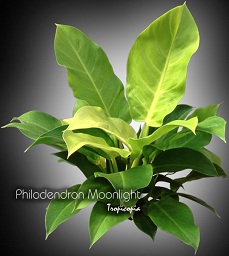Table of contents
Lime philodendron

Latin Name: Philodendron ‘Moonlight’
Category: Philodendron
Family: Araceae
Origin: Cultivar
Climate: Tropical
Growing Zones: 11-10
Care Instructions
The Lime philodendron (Philodendron ‘Moonlight’) is a tropical plant that originates from Cultivar. This philodendron plant belongs to the Araceae family and is well-suited for growing in USDA zones 11-10.
Complete Care Guide for Lime Philodendron (Philodendron ‘Moonlight’)
Watering Requirements
The Lime Philodendron, known for its vibrant, lime-green foliage, thrives best with a consistent watering schedule. It is essential to allow the top inch of soil to dry out between waterings. Overwatering can lead to root rot, a common issue for this plant. During the growing season (spring and summer), water the plant more frequently, approximately once a week, ensuring that excess water drains out of the pot. In the fall and winter months, reduce watering to every two weeks, as the plant’s growth slows down. Always check the moisture level by inserting your finger into the soil; if it feels dry, it’s time to water.
Light Conditions
The Lime Philodendron prefers bright, indirect light but can tolerate lower light conditions. However, for optimal growth and to maintain its vibrant color, place it in a location where it receives filtered sunlight. Direct sunlight can scorch the leaves, leading to brown tips and a loss of vibrancy. If you notice the plant becoming leggy or the leaves losing their bright color, it may be a sign that it needs more light. A spot near a north or east-facing window is ideal, but if you only have south or west-facing windows, use sheer curtains to diffuse the light.
Soil Preferences
The Lime Philodendron thrives in a well-draining potting mix that retains some moisture but does not become waterlogged. A mix designed for houseplants, or a combination of potting soil, perlite, and orchid bark, works well. This blend provides the necessary aeration and drainage that the roots require. Additionally, consider fertilizing the plant every 4-6 weeks during the growing season with a balanced, water-soluble fertilizer diluted to half strength. This will promote healthy growth and vibrant foliage. In the fall and winter, reduce fertilization as the plant enters a dormant phase.
Pests and Diseases
The Lime Philodendron is relatively pest-resistant, but it can occasionally attract common houseplant pests such as spider mites, aphids, and mealybugs. Regularly inspect the undersides of leaves and the stems for any signs of infestation. If you notice pests, treat the plant with insecticidal soap or neem oil, ensuring to cover all affected areas. Additionally, keep an eye out for signs of fungal diseases, which can occur if the plant is overwatered or in overly humid conditions. Yellowing leaves or a mushy stem can indicate root rot, which requires immediate action to save the plant. Ensure proper drainage and adjust your watering schedule accordingly.
Special Care Tips
To keep your Lime Philodendron healthy and thriving, consider the following special care tips: First, regularly wipe the leaves with a damp cloth to remove dust, which can hinder photosynthesis. This also helps to keep the plant looking its best. Additionally, if you notice the plant becoming too large or leggy, you can prune it back to encourage bushier growth. Propagation is also easy with this plant; simply take a cutting with a few leaves and place it in water or directly in soil to root. Lastly, be mindful of temperature; the Lime Philodendron prefers temperatures between 65°F and 80°F (18°C to 27°C) and should be protected from cold drafts and sudden temperature changes.








